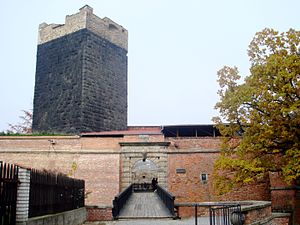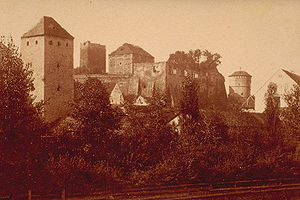Cheb Castle
| Chebský hrad | ||
|---|---|---|
|
Castle and the Black Tower |
||
| Creation time : | 12th Century | |
| Castle type : | Hilltop castle | |
| Conservation status: | torso | |
| Standing position : | Emperor | |
| Construction: | Natural stone | |
| Place: | Cheb | |
| Geographical location | 50 ° 4 '53.1 " N , 12 ° 21' 59.5" E | |
| Height: | 459 m | |
|
|
||
The Cheb Castle (also Eger Castle , Czech Chebský hrad ) is an imperial palace , castle complex and fortress above the Eger River in the town of Cheb in western Czech Republic .
history
Around the year 900 there was a Slavic castle on a mountain spur above the Eger , the foundation walls of which with a cemetery came to light in 1900 during an excavation under the Eger city archivist and museum director Karl Siegl . Around 1120, the surrounding Egerland was by colonization and Christianization meanwhile part of the Nordgau (Bavaria) , was under Margrave Diepold III. von Vohburg built a castle on the mountain spur. This became an administrative center of the Holy Roman Empire when the Egerland came to the Staufers by inheritance in 1167 . From 1179, after the first stay of Emperor Friedrich Barbarossa in the imperial city of Eger ( Cheb ), the castle complex was expanded to become an imperial palace . The impressive Romanesque palace , the black tower and the double chapel of St. Martin were built by 1189 . From 1180 to 1220 the upper chapel of St. Erhard and St. Ursula was designed. After the end of the Staufer period , part of the Egerland was given to the King of Bohemia by pledge , who used the Eger Castle for festivities and representation until 1471. Then the imperial city of Eger, secured by a city wall with guarded gates, became the owner of the facility again and stationed a mercenary troop under a mercenary captain in the outer bailey. After a fire in 1472, the building's living and entrance areas were rebuilt.
During the Thirty Years War , Wilhelm Kinsky and his brother-in-law Adam Erdmann Trčka von Lípa , the faithful of Generalissimo Wallenstein , were murdered in 1634 in the ballroom of Eger Castle , and afterwards he himself was murdered in the Pachelbelhaus on the town square in Eger. Theodor Fontane set a literary monument to this event with the poem Eger Castle .
In 1675, the conversion of the castle complex into a citadel on the border of the Kingdom of Bohemia under the Habsburgs began , which was completed in 1713. Having become insignificant from a military point of view, the castle complex began to fall into disrepair until the town regained ownership of the castle in 1895 and had security work carried out. The castle in Eger survived the First World War unscathed and was spared war damage when the city of Eger was bombed at the end of the Second World War in May 1945. Today the complex is a popular tourist destination, historically and art-historically of interest.
Today's plant
From the imperial palace of the Staufer , built in the Romanesque style, impressive components are still preserved. It is the outer walls of the Palas with multi-part late Romanesque window arcades that give an idea of the importance of this hall.
The "Black Tower", which keep the imperial palace, with humpback blocks of basalt covered is the oldest building of the plant and was a prison tower for political prisoners . The wall thickness on the ground floor is 3.16 meters. In 1774 the tower was raised. This floor is built from rubble stones and is clearly set off in color from the black basalt rock. The tower is 18.5 meters high.
The double chapel of the Kaiserpfalz, one of the few remaining structures from the time of the Roman-German emperors, is structurally largely intact. The ground floor, the chapel of St. Martin in Romanesque style, is divided into eight cross-vaulted fields supported by four granite columns. It was the common room for the emperor's court during services. In the middle of the ceiling area, an octagonal opening connects the lower chapel with the upper chapel, which was dedicated to St. Erhard and St. Ursula and was reserved for the imperial family. The ribbed vault of the upper chapel is supported by white marble columns and shows the transition from the late Romanesque to the early Gothic .
The castle complex was often a construction site in order to keep it usable for the respective owners. But it was also included in the city's festivities and was a venue for the Wallenstein Festival, which took place until 1938. The cross-border horticultural show in Marktredwitz-Cheb in 2006 made it possible to transform the area below the bastion walls into a park. In the summer of 2007, the outer walls in particular were extensively renovated to prevent components from falling.
In the rooms of the castle there is an archaeological collection of finds from the Egerland .
There is a Staufer stele in front of the entrance to the Kaiserburg . It was unveiled on July 12, 2013, the 800th anniversary of the Gold Bull of Eger .
photos
literature
- Pavel Šebesta: Imperial Palace in Eger. Císařská falc v Chebu. In: Archaeological support for the renovation of the Upper Castle in cooperation with the Imperial Palace of Cheb. Edited by the city of Greiz. Greiz 2007, OCLC 255002823 , pp. 52-62.
- Viktor Karell: Castles and palaces of the Ore Mountains and Egertal. Vinzenz Uhl, Kaaden 1935, DNB 366336274 .
Web links
- Castle homepage (Czech, German)
- Eger Castle. In: Burgenwelt.org, January 30, 2016 (German)
Individual evidence
- ↑ Fontane's works in five volumes (= National Research and Memorial Sites of Classical German Literature in Weimar [Hrsg.]: Library of German Classics ). First volume: poems. My childhood years. Memories. Essays and theater reviews. Selected and introduced by Hans-Heinrich Reuter . 3. Edition. Aufbau-Verlag, Berlin / Weimar 1975, DNB 451314522 , pp. 50–53 (Comment p. 374: “The ballad was written in 1849. In the first print (1851) it had the subtitle: 'Oder Drei bohmischer Graf Tod'.").
- ^ Staufer stele Cheb. In: stauferstelen.net, accessed on March 22, 2014 (with historical background information).












